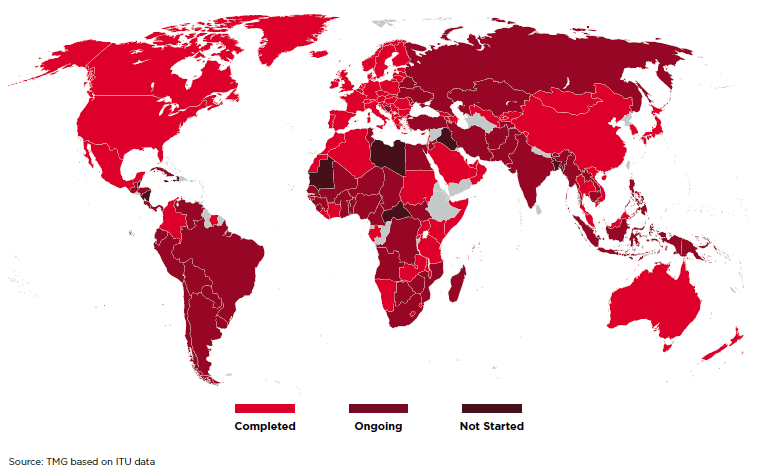This article is part of the Spectrum Policy Trends 2023 report. Download the full report for a handy compilation of the top six spectrum policy trends for 2023.
Digital switchover (DSO) – the process of moving from analogue to digital terrestrial television (DTT) transmission – has been a long and challenging process in many markets. As it nears its global completion in 2023, its digital dividend of enhanced video content distribution and low-band spectrum for rural broadband development is taking hold. In December this year, at the World Radiocommunication Conference (WRC-23), countries in EMEA will decide how that dividend can be maximised for the decades to come.
Low-band spectrum in the sub-1 GHz range supports capacity for wide-area coverage. It promotes digital equality by giving greater access to mobile broadband services in all areas and is an important tool for delivering affordable connectivity to all consumers. In 2023, we expect some of the last countries in Africa, Asia and Latin America to complete a successful DSO as they seek to maximise the economic value of their national spectrum assets.
DSO allows countries to use less broadcasting spectrum due to the greater efficiency of DTT. By improving spectral efficiency, countries can make additional low-band spectrum available for mobile services, including 5G. At the same time, consumers can enjoy a broader array of content offerings and clearer image quality through DTT.
Why does it matter?
DSO frees up more low-band spectrum for mobile. Lower frequencies have superior propagation characteristics than higher bands, determining how far a signal can travel and how well it can penetrate buildings. Sub-1 GHz spectrum is essential to build coverage in thinly populated areas and provide indoor coverage in built-up areas.
There is a direct link between spectrum capacity and download speeds, and increasing low-band spectrum will deliver faster 5G in areas – often rural communities – that are out of the reach of higher bands. The addition of spectrum in the 600 MHz band results in an improvement in rural and deep-indoor 5G speeds by between 30% and 50% and reduces the cost of extending 5G to rural populations by a third. Low-band capacity is at the core of ensuring that high-quality 5G services are available to everyone, but demand for mobile spectrum in low bands always exceeds supply. Using this spectrum efficiently is important, and this efficiency is supported both by DSO and by considering future broadcast spectrum needs.

What are the policy considerations?
Experience of DSO processes on a global level provides clear examples of best practice. The migration experiences of the countries analysed in the “Digital Switchover in Sub-Saharan Africa” report offer a range of valuable lessons for those still completing their digital switchovers. Botswana, Cameroon, Kenya, Senegal, and Tanzania all encountered challenges relating to funding, availability and cost of STBs, regulatory frameworks, consumer outreach, and legal and technical obstacles.
From these DSO experiences, three lessons stand out: the need for flexible approaches, strong consumer outreach and the need for speedy and successful assignment of digital dividends.
It is also important to remember that freeing up spectrum for mobile from the DSO process is only one part of a successful low-band strategy. Meeting low-band needs requires long-term planning from policymakers, and other bands also need to be part of the equation to help meet capacity demands.

What we expect to see in the year ahead
Low-band spectrum can accelerate global digital equality, and this year offers many opportunities for countries to build on this potential. Lessons learned from the growing number of countries that have successfully completed DSO set the stage for further progress in Sub-Saharan Africa, Latin America and Asia. We expect to see technology upgrades and refarming in 800 MHz, 850 MHz and 900 MHz, more countries making 700 MHz available, as well as more deployments and assignments of 600 MHz – all focused on 5G.
Global Status of DSO

At WRC-23, EMEA countries will have the opportunity to review the current use of the 470-694 MHz frequency range. This has the potential to deliver use of the 600 MHz band for mobile in EMEA which would be a significant boost to rural capacity and a driver of digital equality.
At WRC-23, a mobile allocation in 470-694 MHz, with the possibility of an IMT identification, is needed to allow:
- Long-term planning of spectrum below 1 GHz to help 5G lower the digital divide.
- Development of sub-1 GHz spectrum for better rural and in-building connectivity.
- Development of video content distribution mechanisms going into the 2030s.
| Policy Good Practice: Kenya successfully completed the DSO process Kenya successfully completed its digital transition within the timeline established by the ITU of June 2015. This was accomplished despite notable challenges not seen in many countries, including disruptive legal challenges from the broadcasting industry. Its experience primarily highlights the need to maintain flexibility in the face of unexpected roadblocks. Following its successful migration, Kenya has succeeded in reassigning frequencies in the 800 MHz and 700 MHz bands to mobile operators. |